Published online by Cambridge University Press: 14 March 2011
Whatever difference of opinion may exist as to the introduction of Chess into Europe, its Asiatic origin is undoubted, although the question of its birth-place is still open to discussion, and will be adverted to in this essay. Its more immediate design, however, is to illustrate the principles and practice of the game itself from such Oriental sources as have hitherto escaped observation, and, especially, to introduce to particular notice a variety of Chess which may, on fair grounds, be considered more ancient than that which is now generally played, and lead to a theory which, if it should be established, would materially affect our present opinions on its history.
page 1 note 1 ![]() Edited by Manger, “Ahmedis Arabsiadæ Vitæ et Rerum Gestarum Timuri, qui vulgo Tamerlanes dicitur, Historia. Leov. 1772, 4to;” and also by Golius, 1736.
Edited by Manger, “Ahmedis Arabsiadæ Vitæ et Rerum Gestarum Timuri, qui vulgo Tamerlanes dicitur, Historia. Leov. 1772, 4to;” and also by Golius, 1736.
page 1 note 2 Syntagma Dissertationum, &c. Oxon, MDCCLXVII., containing “De Ludis Orientalibus, Libri duo.” The first part is “Mandragorias, seu Historia Shahi ludii, Horis successivis olim congessit Thomas Hyde, S.T.P.”
page 2 note 1 Dr. Hyde does not give a complete table of his Oriental authorities; but in the list of works on Chess, at the end of his Dissertation, page 156, are named the following:—
page 2 note 1. Lib. Arab, ![]() De excellentia Shahiludii supra Nerdiludium, Autore Sokeiker Damascene.
De excellentia Shahiludii supra Nerdiludium, Autore Sokeiker Damascene.
page 2 note 2. Lib. Arab. De Shahiludio, Autore Al Sûli.
page 2 note 3. Lib. Arab. De Shahiludio, Autore Al Damîri.
page 2 note 4. Lib. Arab. ![]() Apologeticus pro Ludenti bus Al Shatrangj, Autore Al Râzi, qui vulgò Rasis.
Apologeticus pro Ludenti bus Al Shatrangj, Autore Al Râzi, qui vulgò Rasis.
page 2 note 8. Ala-eddîn Tabrizensis ![]() Commentarius de Ludo Shatrangj. Vide Tiûuri Hist. Arab., p. 428. Hie fortè is sit qui apud Saphadism ut optimus Lusor celebratus est, quando tandem cœcus esset.
Commentarius de Ludo Shatrangj. Vide Tiûuri Hist. Arab., p. 428. Hie fortè is sit qui apud Saphadism ut optimus Lusor celebratus est, quando tandem cœcus esset.
page 2 note 2. It contains also the signature of H. Ross, with the addition “the gift of Robert Holford.” I give these particulars to indicate, by the names of its former possessors, its history, or from whence it came. It is numbered 250, according to the present arrangement of the Society's Manuscripts, in Mr. Morley's Catalogue.
page 3 note 1. To facilitate inquiry for a more perfect copy of the work, and to enable it, when found, to be identified, the first few lines are here given of the fragment which commences the MS.:—

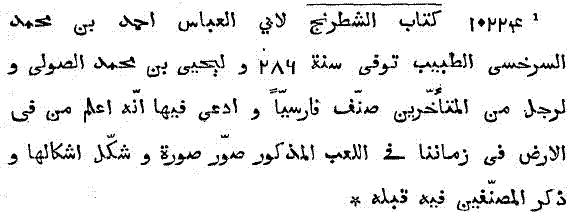
10224. Kitáb el-shitrenj, liber ludi latrunculorum, auctoribus Abu'l Abbás Ahmed Ben Mohammed Serakhsi Medico, anno 286 (inc. 17 Jan. 899) mortuus— Yahya Ben Mohammed Sauli, et recentiore quodam viro, qui Persice scripsit, et non sine arrogantia gloriatur, se ludi illius hae nostra ætate in toto terrarum orbe peritissimum esse. Delineavit formam tabulæ latrunculariae et figuras depinxit, auctoresque qui ante de hoe ludo seripserint, recenset.—Haji Khalfæ Lexicon, tom. V. p. 104. Edition of Fluegel.
page 4 note 2 The terms Mansúbah and Tâbíah are explained in a later part of this essay.
page 5 note 1 
page 7 note 1 For an account of the game of Nerd, see “Historia Nerdiludii,” following the “Historia Shahiludii,” in Hyde's Dissertations.
page 7 note 2 A similar intention in the first arrangement of Chess is alluded to in Masudi's Murtúj ul Zeheb, v. Dr. Sprenger's Translation, vol. i., p. 172.
page 10 note 1 The names and properties of these pieces are fully explained by Hyde; also in a small work called the History of Chess, &c, pp. 90 to 121, by the Rev. R. Lambe, published in 1764, and again, anonymously, in the following year.
The corruption of the original names of the Chess-men retained in the European game, occasions a little difficulty in referring to them in connection with those additional pieces for which there is no such familiar translation. To call by its proper name of Elephant, the Fíl (our Bishop), might cause it to be confounded with our Castle (the Rook, or Rukh), frequently imaged in our sets as a castellated Elephant. Queen is also a term singularly inappropriate to Eastern chess, yet it is almost impossible to avoid it in the expression “to queen,” in the play of the Pawns, which necessarily introduces the name of Queen for the piece itself. I have in some instances united the terms of both systems, in such a manner, however, as to leave them still intelligible to any chess-player. In describing the Complete Chess, I have retained all through its proper terms, either in Persian or English, as Horse or Asp for our Knight, Elephant or Píl for Bishop, Ferzín for Queen, &c.; but where merely general principles are discussed, and in the explanation of Positions in the Short Game, I have used the terms familiar to European players. This applies also to the names for the greater and lesser form of board, varying with the works quoted, or the bearing of the argument.
page 11 note 1 Some figures of Eastern chessmen are exhibited by Hyde, pp. 123–4, which may assist the comparison. An Oriental inkstand is engraved in Herbin's Traité de Calligraphie, 4to.
page 11 note 2 The moves described in the MS. as “well known,” differ in many respects from those of the corresponding pieces in our game. The piece we call Queen moves only one square at a time, and always diagonally, like our Bishop, to which consequently it is inferior in power, and is, in fact, the weakest on the board. The Píl, or Bishop, moves two squares diagonally, but commands only the square to which he plays, and not the intervening square, which may even be filled by another piece without affecting the move. The other chess-men have the same power as those of our game, except that the Pawns never advance more than one square at a time. The diagram, fig. 1 in pl. ii., will further exemplify the moves.
For these rules, which are not found in any Oriental treatise, and can only be obtained from an attentive examination of their examples of games and positions, I am indebted to the kindness of Professor Duncan Forbes, who, in addition to his varied and profound literary acquirements, is well known to his friends as an ingenious and accomplished chess-player.
page 12 note 1 The moves of the Camel and Zaráfah present difficulties which our present resources do not enable us to explain. The Mixed Move evidently resembles that of the Knight, as combining the Straight and Oblique movement, and the proportionate strength of the two more powerful pieces in that class may be inferred to be the privilege of clearing a greater number of squares, but to what extent, is a subject for further inquiry.
page 13 note 1 See later, where these terms are treated of.
page 13 note 2 ![]() A king of Canúj, of this name, is said to have been contemporary with the Alexander the Great of Perslan history.
A king of Canúj, of this name, is said to have been contemporary with the Alexander the Great of Perslan history.
page 14 note 1 A Dirhem, or silver piece, in Muhammedan money, is usually calculated to be worth about sixpence, and to be divided into four Dánks.
page 16 note 1 Al Rázi, quoted in the preface, died A.H. 310 or 320 = A.D. 922 or 932, which date is the only limit we can assign to the age of the MS.
page 16 note 1 De situ Iusuum, p. 135. “(Thema) Primum vocatur ![]()
![]() Thema Adali, i.e. æquale, eo quod Lusori incidat cum æquali.” Page 136, “Octavum vocatur
Thema Adali, i.e. æquale, eo quod Lusori incidat cum æquali.” Page 136, “Octavum vocatur ![]() Thema Al Rabrab, i.e. Agmen boum sylvestrium.”
Thema Al Rabrab, i.e. Agmen boum sylvestrium.”
page 18 note 1 Presented by Major Yule, and numbered 151.
page 18 note 2 ![]()
page 18 note 3 
page 19 note 1 Hyde, p. 40. Cap. An Shahlludium sit licitum.
page 21 note 1 ![]() Verse, probably a quotation.
Verse, probably a quotation.
page 21 note 2 ![]() Apparently one of the Bishops of greater value in drawing the game at the end; but I am unable to explain the reason.
Apparently one of the Bishops of greater value in drawing the game at the end; but I am unable to explain the reason.
page 23 note 1 Jumping over the Knight, according to the Eastern game. Dilaram's Mate Jias been published by Mr. G. Walker in the Palamède, and in some other Chess periodicals, but I am unable to state from what original Persian source.
By making the mask with the Knight on the Rook's 2nd, the Bishop being already placed on his own 5th, this game may be accommodated to the European system; the play will then be (2nd move) Kn. to his 4th, disc. ch.; the remaining moves as before. Another piece or pawn, of either colour, must also be placed on Blaok K's 3d, otherwise there would be Mate on the move.

![]()
![]() The note in Manger's edition, Vol. II. p. 877, adds, “Mendosè in Gol. Ed. prostat
The note in Manger's edition, Vol. II. p. 877, adds, “Mendosè in Gol. Ed. prostat ![]() Ali ludebat absens, quod turbat, pro
Ali ludebat absens, quod turbat, pro ![]() Ali victoriosus, qui nunquam in ludo succumberat.” Manger, therefore, translates the passage, “Ludebat Ali ille victor cum duobus simul adversariis, et monstrabat, cum moveret, quantus esset solus adversus duos.”
Ali victoriosus, qui nunquam in ludo succumberat.” Manger, therefore, translates the passage, “Ludebat Ali ille victor cum duobus simul adversariis, et monstrabat, cum moveret, quantus esset solus adversus duos.” ![]() is also badly rendered here “cum moveret;” Tarh signifying not a “move,” but “advantage given;” a meaning not in our Dictionaries, and overlooked by Manger in another passage, p. 874, 1. 7.
is also badly rendered here “cum moveret;” Tarh signifying not a “move,” but “advantage given;” a meaning not in our Dictionaries, and overlooked by Manger in another passage, p. 874, 1. 7.
page 27 note 1 ![]() “The Delight of the Intelligent, in description of Chess-play,” MS., No. 146 of Dr. Lee's Catalogue of his Oriental collection, and No. 76 of the New Catalogue.
“The Delight of the Intelligent, in description of Chess-play,” MS., No. 146 of Dr. Lee's Catalogue of his Oriental collection, and No. 76 of the New Catalogue.
page 28 note 1 ![]() No. 147 of the Old Catalogue, and 77 of the New. The author of the Anmúzaj, Ibn Abi Hajlah, composed also the history of Egypt, entitled Sukkerdán, Sugar-Bason. “Ahmed ben Yahya Tilimsáni, vulgo Ibu Abi Hejla, ob. 776 = 1374.” (Fluegel's Haj. Khalf. 7191.
No. 147 of the Old Catalogue, and 77 of the New. The author of the Anmúzaj, Ibn Abi Hajlah, composed also the history of Egypt, entitled Sukkerdán, Sugar-Bason. “Ahmed ben Yahya Tilimsáni, vulgo Ibu Abi Hejla, ob. 776 = 1374.” (Fluegel's Haj. Khalf. 7191.
page 29 note 1 ![]() A grammatical treatise by the celebrated Hariri.
A grammatical treatise by the celebrated Hariri.
page 29 note 2 In the life of Abú Bekr al Súli. See Vol. III. of De Slane's Translation, P. 71.
page 30 note 1 The Warm, the Cold, the Wet, and the Dry, which correspond with the four component parts of the human frame, and are introduced by Arabian doctors into the whole system of Physics.
page 31 note 1 The whole title is ![]() interpreted in Baron Hammer-Purgstall's Catalogue of his MSS., in which the work is fully described, “Der Kenntnisse Kostbarkeiten aus der Quellen Braiiten,” and in English may perhaps be rendered, with a slight paraphrase of the original, “Treasures of Science from Virgin Sources.” There are copies in the East India House Library, and in the Gore Ouseley collection, and another, slightly imperfect, in the possession of the writer of this note. The part relating to chess is, in some of the copies, so incorrect as to require careful collation with all the others. The chess diagrams found in them are to be followed with still greater caution, many of them not even agreeing with the text.
interpreted in Baron Hammer-Purgstall's Catalogue of his MSS., in which the work is fully described, “Der Kenntnisse Kostbarkeiten aus der Quellen Braiiten,” and in English may perhaps be rendered, with a slight paraphrase of the original, “Treasures of Science from Virgin Sources.” There are copies in the East India House Library, and in the Gore Ouseley collection, and another, slightly imperfect, in the possession of the writer of this note. The part relating to chess is, in some of the copies, so incorrect as to require careful collation with all the others. The chess diagrams found in them are to be followed with still greater caution, many of them not even agreeing with the text.
page 32 note 1 But ![]() probably with the different power already assigned to them in the Great Chess.
probably with the different power already assigned to them in the Great Chess.
page 32 note 2 Ibn Arabshah, p. 877, mentions the Round and Oblong games among the varieties of Chess played at Timur's Court: ![]()
![]() and this Round Board has also been reputed the invention of Timur, as well as the Great Chess Board; both on equally slight authority.
and this Round Board has also been reputed the invention of Timur, as well as the Great Chess Board; both on equally slight authority.
A round board, similar to fig. 3, pl. IV., but with pieces differently arranged, is engraved in Strutt's Sports and Pastimes.
page 32 note 3 One MS. has ![]() a Lion, no doubt a mistake in the points, for
a Lion, no doubt a mistake in the points, for  .
.
page 33 note 1 Commonly known as the Táríkĭ Wassáf, but the proper title is ![]() by Abdullah Fazlullah, surnamed Wassáf ul Hezrat.
by Abdullah Fazlullah, surnamed Wassáf ul Hezrat.
page 34 note 1 ![]() “Rubinen des Zarten im Lobe und Tadel jedes Dinges,” by Al Saalabi. Hammer-Purgstall's Handschriften, No. 11.
“Rubinen des Zarten im Lobe und Tadel jedes Dinges,” by Al Saalabi. Hammer-Purgstall's Handschriften, No. 11.
page 34 note 2 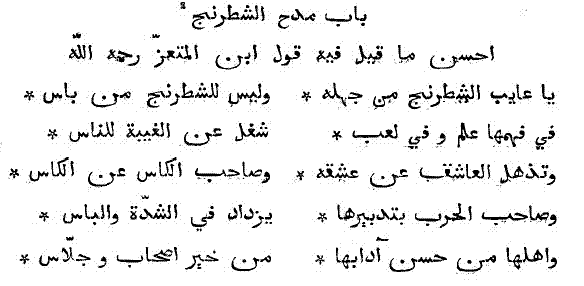

page 35 note 1 It is to be found, in translation, in Von Hammer's Rosenœl, 2nd vol., or Flaeschchen. The story is too long for insertion here, and would suffer by abridgement.

This interesting anecdote, both in text and translation, was kindly communicated to me by the Rev. G. Hunt, of Plymouth. It is taken from one of the numerous MSS. containing anecdotes of Harún, and the imperfections of the copy, as shown by the inclosure of brackets, have been supplied by Mr. Hunt himself, as well as the following note:— “The MS. reads ![]() (3rd line), which cannot be right. For if Harun only wanted to know whether Jafar or Abbasiah was a better player than himself, he could ascertain that without bringing Jafar and Abbasiah together in his presence. Both beat him, and what he wished to see was which of the two would beat the other, and this could not be unless they met, and they could not meet, according to Oriental etiquette, unless married.”
(3rd line), which cannot be right. For if Harun only wanted to know whether Jafar or Abbasiah was a better player than himself, he could ascertain that without bringing Jafar and Abbasiah together in his presence. Both beat him, and what he wished to see was which of the two would beat the other, and this could not be unless they met, and they could not meet, according to Oriental etiquette, unless married.”
page 36 note 2 In the “Story of the Second Royal Mendicant,” according to Lane's translation. It is to be regretted that Mr. Lane has not taken an opportunity of bestowing on us, from his extensive resources of learned research and practical experience, some detailed information on the present or former practice of Chess in Egypt. In a Note (67), the game is said to be “played somewhat differently in different parts of the East.”
page 36 note 3 Pepin's son killed the son of King Ottocar of Bavaria in this manner. The story, as related by Selenus of Lunenburg, and repeated in the poem Quirinalia, in the twelfth century, is cited, with numerous similar anecdotes from the early Chronicles, by Sir Frederick Madden, in his learned “Historical Remarks on the Introduction of the Game of Chess into Europe,” &c, in the Archæologia, Vol. XXIV. 1832.
A monkey also plays chess in a story related in the Palamede, Vol. I. 1836— “Le Singe et le Gascon.”


page 38 note 1 ![]() printed at Constantinople, A.H. 1206 = 1791.
printed at Constantinople, A.H. 1206 = 1791.
page 38 note 2 Ziáï ![]() according to the Atesh Kedah, came from his native place, Ardúbád, to Herat, and entered the service of the celebrated Emír AH Shír. After the fall of the Gúrgán power, he fled from Khurasan to Azerbaijan, and died at Tabriz in that province, A.H. 927 (A.D. 1520). Ziáï was chiefly a lyric writer.
according to the Atesh Kedah, came from his native place, Ardúbád, to Herat, and entered the service of the celebrated Emír AH Shír. After the fall of the Gúrgán power, he fled from Khurasan to Azerbaijan, and died at Tabriz in that province, A.H. 927 (A.D. 1520). Ziáï was chiefly a lyric writer.
page 39 note 1 ![]() “Schlüssel der Glückseligkeit and Leuchte der Herrschaft,” Handschriften Hammer-Purgstall's, No. 12.
“Schlüssel der Glückseligkeit and Leuchte der Herrschaft,” Handschriften Hammer-Purgstall's, No. 12.
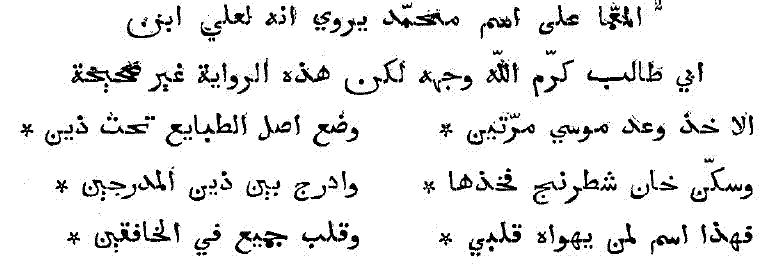
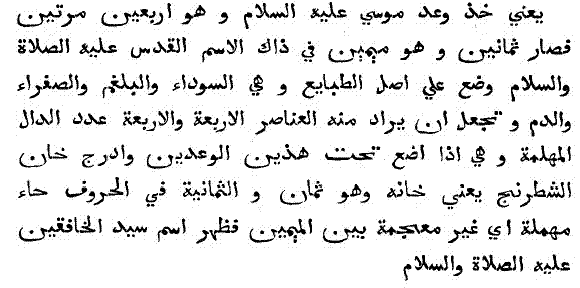

The MS. is in the Collection of rich, No. 7567, and is called “;Diwan Ibn al Afif et alia.’
page 43 note 1 This game seems also to have had a place in Dr. Hyde's authorities, though, not meeting with the tale connected with it, he mentions the Position as “Mansûbo 'l Gjâriya, i. e., Thema Lusûs currentis.” ![]() evidently refers to it as Thema Puellœ, vel Aneillœ; Scil. Dilaramœ.
evidently refers to it as Thema Puellœ, vel Aneillœ; Scil. Dilaramœ.

Though Mausúbah means merely a Position at Chess, the words Mansúbahbáz are here translated ‘Gambit-player,’ for want of a suitable expression.

page 45 note 1 Shashder is the Board at Nerd or Backgammon. Several of the Chess terms in this and other extracts are not yet sufficiently illustrated to enable us to understand them. Some few of them are explained later.
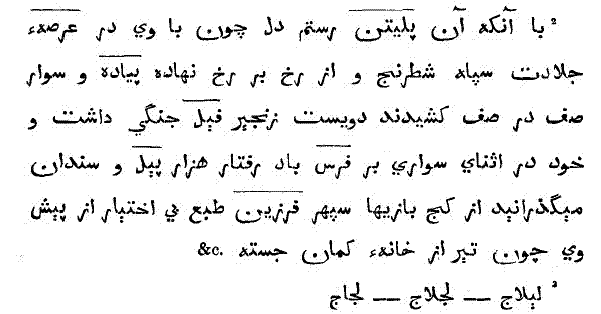
page 46 note 1 
page 46 note 2 This couplet, and one similar, p. 43, seem to controvert the prevailing opinion that the squares in Eastern Chess are not of different colours. It is nowhere so stated in their treatises. MS diagrams are, necessarily, alike, as even in engraving it requires a complicated process to represent the pieces on coloured squares.
page 47 note 1 In Johnson's Persian and Arabic Dictionary, “Mansúbah” is called “the game of Chess,” instead of “a (particular) game or position at Chess.”
page 47 note 2 ![]() is the Noun of Action of the 2d conjugation of
is the Noun of Action of the 2d conjugation of ![]() which is explained, “Instruxit aciem vel exercitum.”
which is explained, “Instruxit aciem vel exercitum.”
page 49 note 2 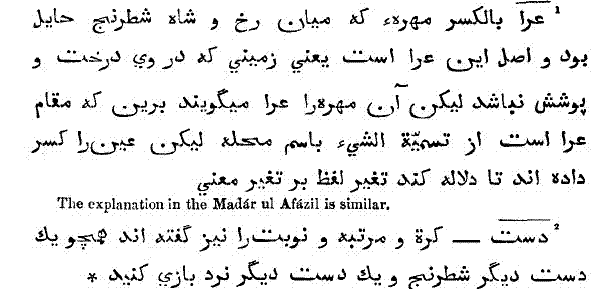
page 50 note 1 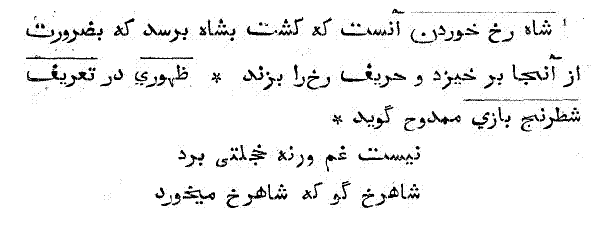
page 51 note 1 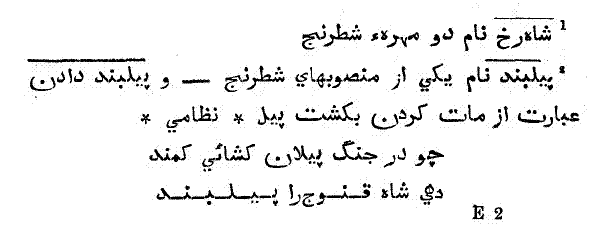
page 52 note 1 
page 52 note 2 Page 132, 4to edition. “Cum aliquando luderem cum Arabe Hierosolymitano,” &c. The writer of this note has heard the same word used by an Arab of Western Africa, who said it was Persian, and signified “Move (out of cheek),” and it might almost have been supposed to be a corruption from the word Kashídan ![]() “to withdraw, or remove,” which would correspond with the interpretation as
“to withdraw, or remove,” which would correspond with the interpretation as ![]() “Ito, migra,” by Dr. Hyde's “Arabs Hierosolymitanus.”
“Ito, migra,” by Dr. Hyde's “Arabs Hierosolymitanus.”
page 52 note 3 ![]() This treatise would be invaluable, in explaining much which we can never hope to understand in the game, without such direct authority, and the present opportunity is taken to invite attention to it, should it still be extant in manuscript collections.
This treatise would be invaluable, in explaining much which we can never hope to understand in the game, without such direct authority, and the present opportunity is taken to invite attention to it, should it still be extant in manuscript collections.
page 52 note 4 The uncertainty of text in native dictionaries causes much difficulty in quoting from them, and renders the definitions they contain comparatively unavailable. This objection particularly applies to those which, like the Madár ul Afázil and the valuable Bahárĭ Ajam, are of more rare occurrence; and also, in the present instance, to most of the original sources consulted, the copies of which, especially the chess treatises, are, as far as the Editor is informed, unique.
page 53 note 1 
page 53 note 2 ![]() “Regem occidere dicitur de Rege Shatrangico.” The quotation, properly, should run thus, —
“Regem occidere dicitur de Rege Shatrangico.” The quotation, properly, should run thus, — ![]() and its translation would be: “Shah has three significations,—the 3rd is, to check (kisht kerdan) the King at chess.” Even Meninski, who frequently quotes Hyde for chess terms, explains Kisht, “Vocabulum in ludo latrunculorum, ubi Rox eorum petitur,” and calls it a corruption of Kish; and, similarly, the phrase Kisht kerdan. Johnson's Persian Dictionary also gives Kisht and Kish, Check at Chess.
and its translation would be: “Shah has three significations,—the 3rd is, to check (kisht kerdan) the King at chess.” Even Meninski, who frequently quotes Hyde for chess terms, explains Kisht, “Vocabulum in ludo latrunculorum, ubi Rox eorum petitur,” and calls it a corruption of Kish; and, similarly, the phrase Kisht kerdan. Johnson's Persian Dictionary also gives Kisht and Kish, Check at Chess.
page 54 note 1 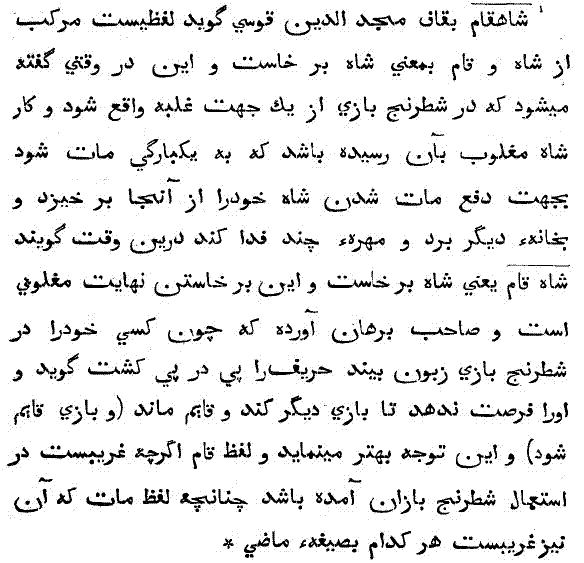
page 55 note 1 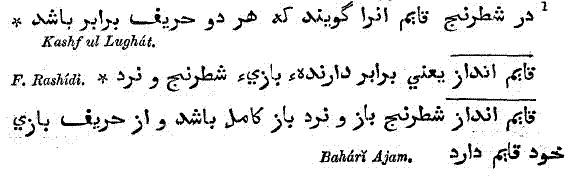
page 56 note 1 ![]() “ransom” or “hostage,” naturally applies to the piece which, as it were, offers its life to save the King by interposing between him and the enemy, and the expression is frequent in Eastern chess books. The words At, Fát, and Tát, which have no meaning in Arabic or Persian, seem invented merely as parallel sounds to Mát.
“ransom” or “hostage,” naturally applies to the piece which, as it were, offers its life to save the King by interposing between him and the enemy, and the expression is frequent in Eastern chess books. The words At, Fát, and Tát, which have no meaning in Arabic or Persian, seem invented merely as parallel sounds to Mát.
page 57 note 1 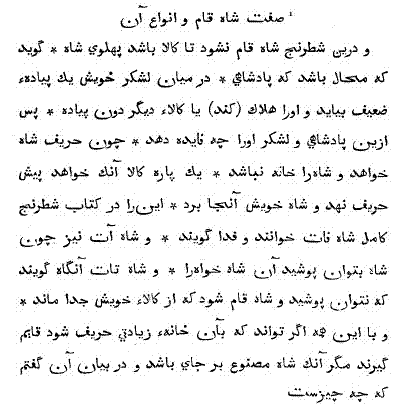 The text is an exact copy, the points only being occasionally supplied, and one word in brackets, together with the necessary orthographic marks.
The text is an exact copy, the points only being occasionally supplied, and one word in brackets, together with the necessary orthographic marks.
page 58 note 1 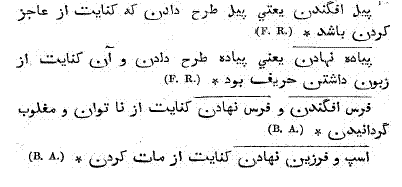
page 61 note 1 Pl. I.
page 61 note 2 The form is well known, and appears in Pl. III. fig. 1.
page 61 note 3 Described as similar to the common Square Chess, but no drawing is given.
page 61 note 4 Pl. IV. fig. 3, from the Nefáïs.
page 61 note 5 Figures 1 and 2, Pl. IV., from two different MSS. of the Nefáïs.
page 61 note 6 The figure given in the Nefáïs is incomplete, and, evidently, inaccurate.
page 62 note 1 Hyde; Cap. De Scaecario, p. 75: or in Macan's edition of the Shah Namah, Vol. IV. p. ![]() the whole part relating to Chess extending from p.
the whole part relating to Chess extending from p. ![]()
page 62 note 2 By Polydore Virgil, and others. In the illustrated edition of the Nuremberg Chronicle is found a portrait of Xerxes Philosophus, with the chess-board arranged before him.
page 62 note 3 An author quoted by Dr. Hyde writes ![]() .
.
page 63 note 1 On the Indian Game of Chess. Asiatic Researches.
page 63 note 2 The Board of Chaturanga is exhibited in pl. II. fig. 2, from the description furnished by Sir W. Jones' Essay. The form of the Chinese Chess is given in a I plate in Hyde's work.
page 64 note 1 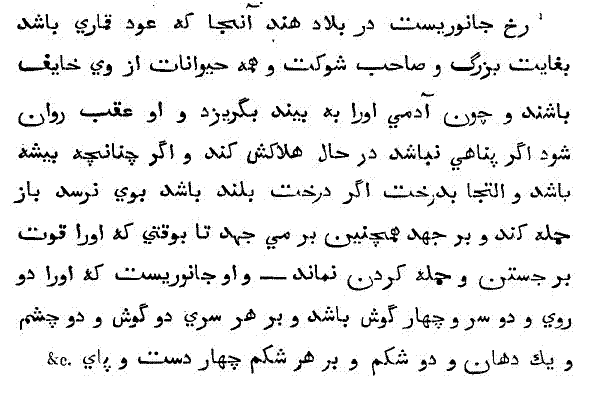
page 65 note 1 The word in the MS. might he either Gurg (Wolf) or Kerg, the same as Kergadan (Rhinoceros), which would agree with the account in Hyde.
page 65 note 2 
page 66 note 1 Dr. Hyde writes of it as having two humps. The Ráhilah, or Dromedary, is, however, only a swifter breed of the single-bunched Arab Camel; v. Russell's Aleppo, vol. ii., and even Hyde's plate of Indian chess-men figures the Rukh as a Camel with one hump.
page 67 note 1 In the title page it is called “Essays on Chess, adapted to the European mode of play, &c., by Trevangadaeharya Shastree. Bombay, 1814.”
The rules may be abridged thus, observing a different order, as more convenient:—
I. The King on one side is opposite to the other player's Queen.
X. He who has won most games, moves first.
IX. The first four or eight moves may, by agreement, be placed for beginning the game.
VIII. The Kings' and Queens' Pawns may move two squares at their first move, if the pieces to which they belong are in place; other Pawns only one square.
VI. No Pawn can go to the last line, nor take any piece on that line, so long as the master piece of his own file remains.
V. In queening, the Pawns obtain the powers of the pieces to which they belonged, except the King's Pawn, which becomes a Queen. The Knight's Pawn also is entitled to one move as a Knight, in addition to that by which he queens.
VII. The King may not castle, but once in the game is allowed the Knight's move, if not previously checked. He may not, however, take with this move.
II. There are three modes of winning—Boorj, when no piece is left. This is the least creditable, and by some called Drawn; 2nd. Checkmate, the adversary having one or more pieces remaining; 3rd. Checkmate with a Pawn, called Piedmát, the adversary having some pieces left. This is the best mode.
III. There is no Stale Mate; the adversary must make room by moving. In some parts of India, one of the adversary's pieces, at choice, may be removed for that purpose.
IV. No game can be drawn by Universal Check; the party checking must make another move.
In the fly-leaf of the copy referred to is found the following note, which, after omitting the names quoted and also the signature, may be inserted here:—
“The author, familiarly known in the Bombay Presidency by the name of the Brahmin, was said never to have lost a game at Chess, except one, in which he allowed himself to be beaten by a lady. Even here, however, the Brahmin had not miscalculated—the lost game secured him a Bullock Contract.
“I was assured by my friend * * * that, on the famous Position, called Phillidor's Legacy, being submitted to him, after five minutes' consideration, he divined the move.”